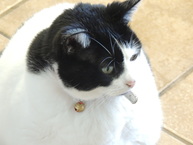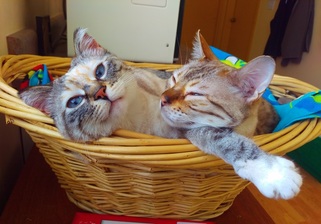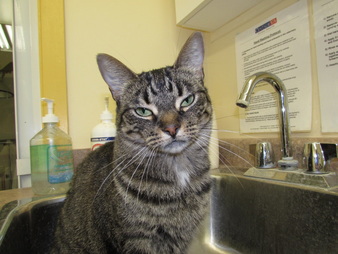What is FLUTD?Feline lower urinary tract disease (FLUTD) is an inflammatory condition of the bladder and/or urethra in cats. This inflammation may be caused by urinary crystal formation, bacterial infection or (very rarely) cancer, but often a cause is never found. Inflammation in the urinary tract causes a variety of symptoms including increased frequency of urination, difficulty urinating, inappropriate urination (going outside the litterbox), blood in the urine, and vocalizing (crying or howling) when trying to urinate. Feline lower urinary tract disease usually develops early in a cat’s life, and tends to cause episodes of urinary issues throughout their lifetime. Understanding some of the risk factors of FLUTD can help in managing this condition to prevent recurrence of urinary signs. Which cats are at risk for developing FLUTD?Determination of risk can be made within three categories:
How can I help my cat manage FLUTD?Step 1. Manage Lifestyle and Diet  Since overweight cats are at higher risk of developing FLUTD, encouraging weight loss may help prevent further episodes of urinary issues. This can be accomplished in a few ways:
One of the most common causes of FLUTD (inflammation in the bladder) is urinary crystals. Transitioning to a diet that dissolves and prevents re-formation of crystals is an essential component of managing FLUTD, especially if crystals are identified in your cat’s urine.
Maximizing water intake will help flush out urinary crystals, bacteria and inflammatory cells and will promote urinary tract health long term.
Step 2. Manage Stress and Inflammation  Stress promotes inflammation of the bladder, therefore minimizing stress minimizes bladder inflammation and the resultant symptoms of FLUTD. This can be accomplished by:
Since inflammation of the bladder is a central component of FLUTD, anti-inflammatories are often used short-term to control flare ups.
If a large amount of bacteria was identified on urinalysis, your cat may be prescribed an antibiotic to control this bacteria and therefore reduce any inflammation it may be causing. Step 3. Manage Litterbox Habits It is ideal to have more litterboxes than there are cats in a household.
Litterboxes should be spaced out in the house, ideally in places where your cat prefers to go.
 The litterboxes should be cleaned out once to twice a day and topped up with fresh litter each time to make sure your cat has enough material to bury their waste in.
As always, please feel free to discuss any questions or concerns you may have with any of our staff - either in the comment section below or through the clinic. We typically carry the Feliway pheromone spray in stock.
3 Comments
10/28/2017 06:17:28 am
I would like to say that 'streptomycin or amoxicillin' is the dominant method of healing for the pets with urinary tract diseases. The course of treatment for the pets with first-time ailments is generally 10-12 days. But this remedial treatment with sulfa drugs may last for four weeks or even longer for the pets with frequent urinary tract infections. In that case, it is very crucial to unearth the kind of pathogen spreading this virus, and the ampicillin will take the life of that germ. I don't think a pet owner can determine all these things on his own unless he is a vet. So, better a pet owner should consult a vet who can not only identify the bacteria but also provide necessary therapy for killing that bacteria from the root.
Reply
Thanks for helping me understand that medication might be prescribed for a cat to help with their inflammation and discomfort. I wonder what ampicillin for injectable suspension would be used for, because I just read about it online earlier. It might be important for farm animals and pet owners to communicate with veterinarians to actually understand them and their uses.
Reply
I used to have a lot of trouble with my cat peeing outside the litter box, and it was causing me a lot of stress and frustration. But then I discovered the Stop Cat Peeing Online program and it has made all the difference. The program offers practical solutions and a supportive community of cat owners who are all going through similar issues. It's been really helpful to connect with others who understand what I'm going through.
Reply
Leave a Reply. |
We've put together some of our knowledge into short articles to help keep your pet healthy.
ArticlesStress Free Moving: Helping Your Cat Adjust To A New Home
Protect Your Cat: 4 Diseases You Can Vaccinate Against Some Thought For Food: Are Raw Meat Diets Worth It? What to Know About Grain Free Diets The Truth About By-Products In Pet Food What to do About Feline Lower Urinary Tract Disease Categories
All
|
|
LOOKING FOR LARGE ANIMAL SERVICES?
Hicks Veterinary Services is our new large animal division. |
SEEING DOUBLE?
You may notice that our website looks very similar to the Arthur Veterinary Clinic. That is because we are sister clinics in the community and share a lot with each other. We wanted to make it as easy as possible for you to access our services so we made similar sites. |
Proudly powered by Weebly

 RSS Feed
RSS Feed

